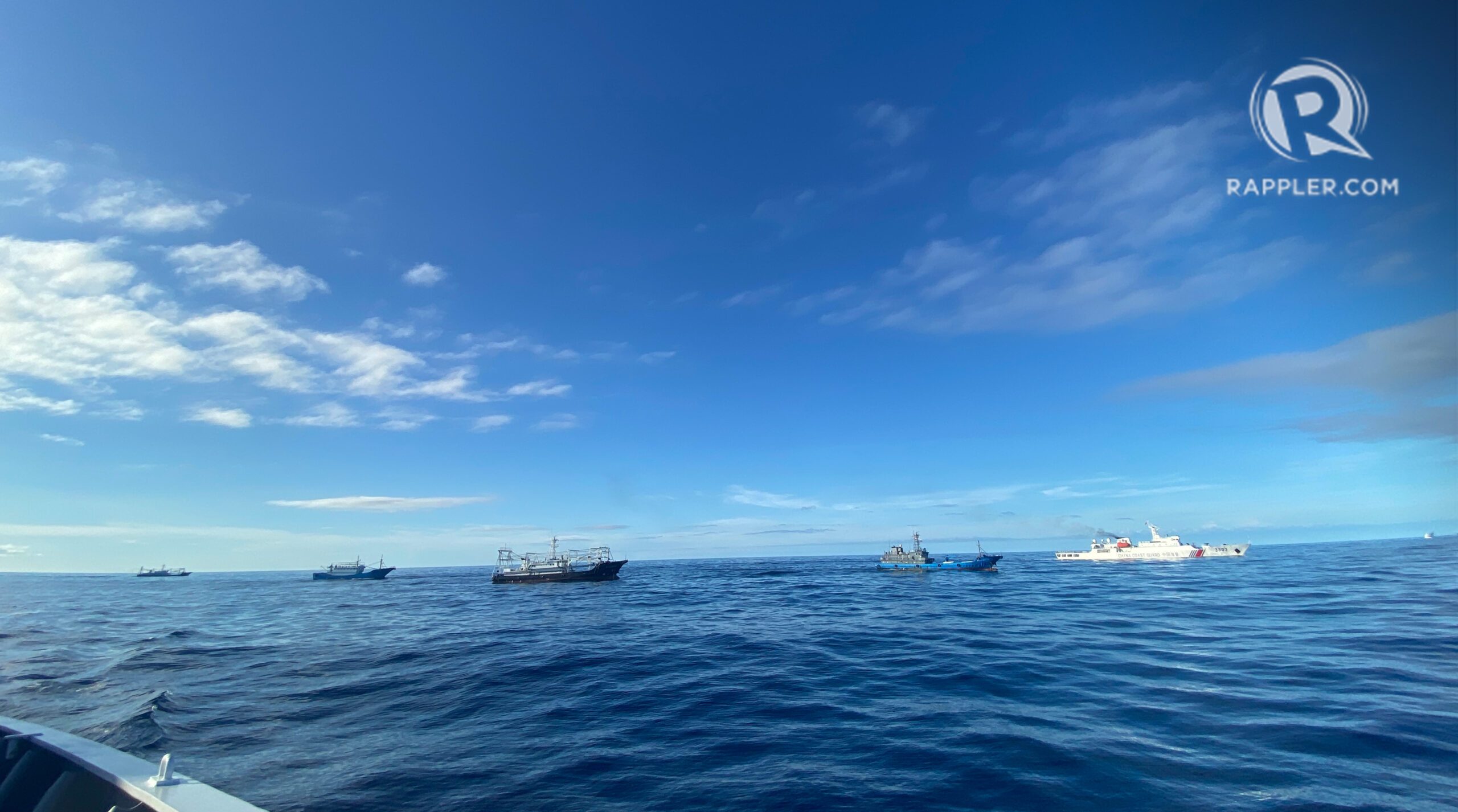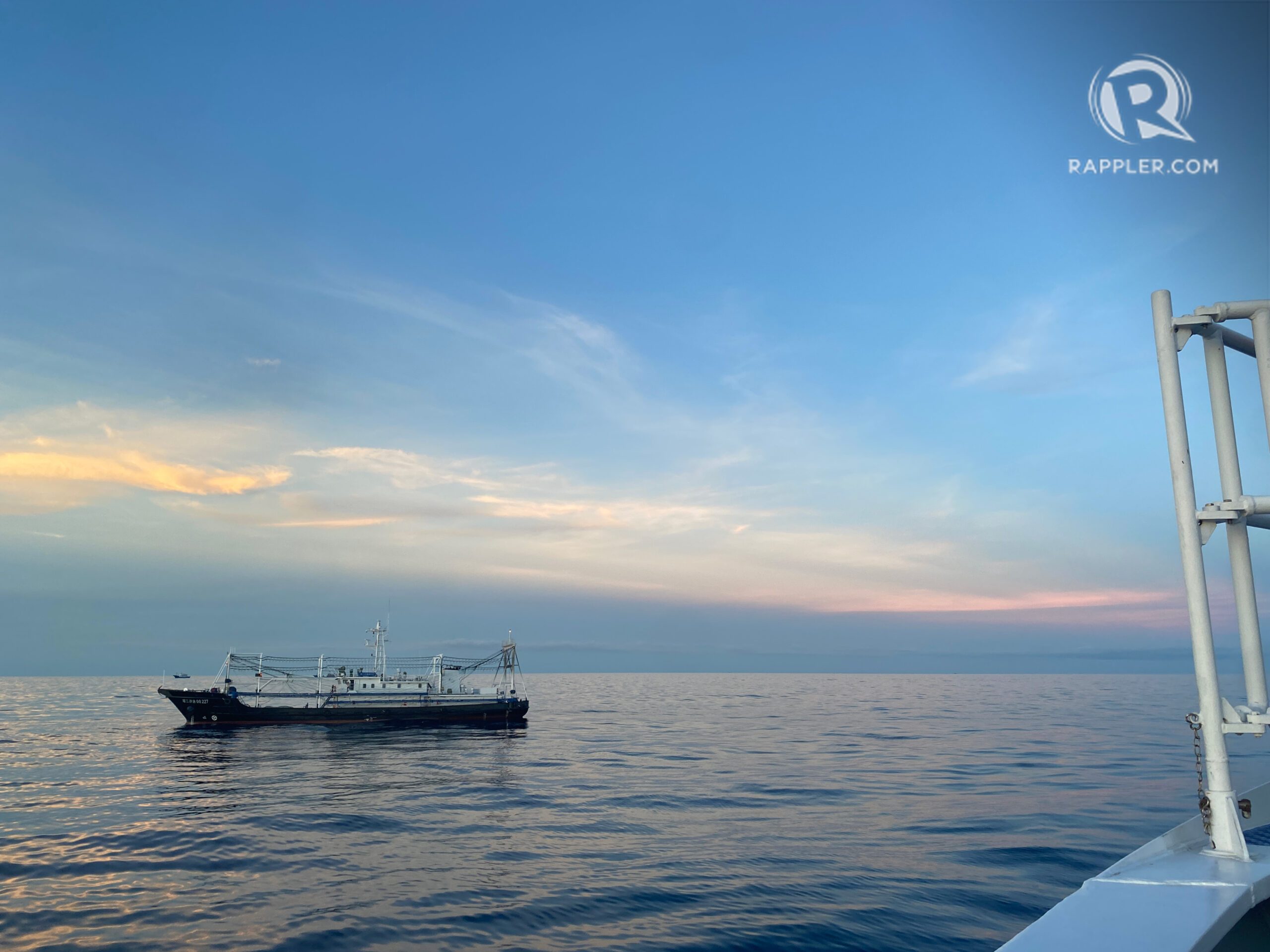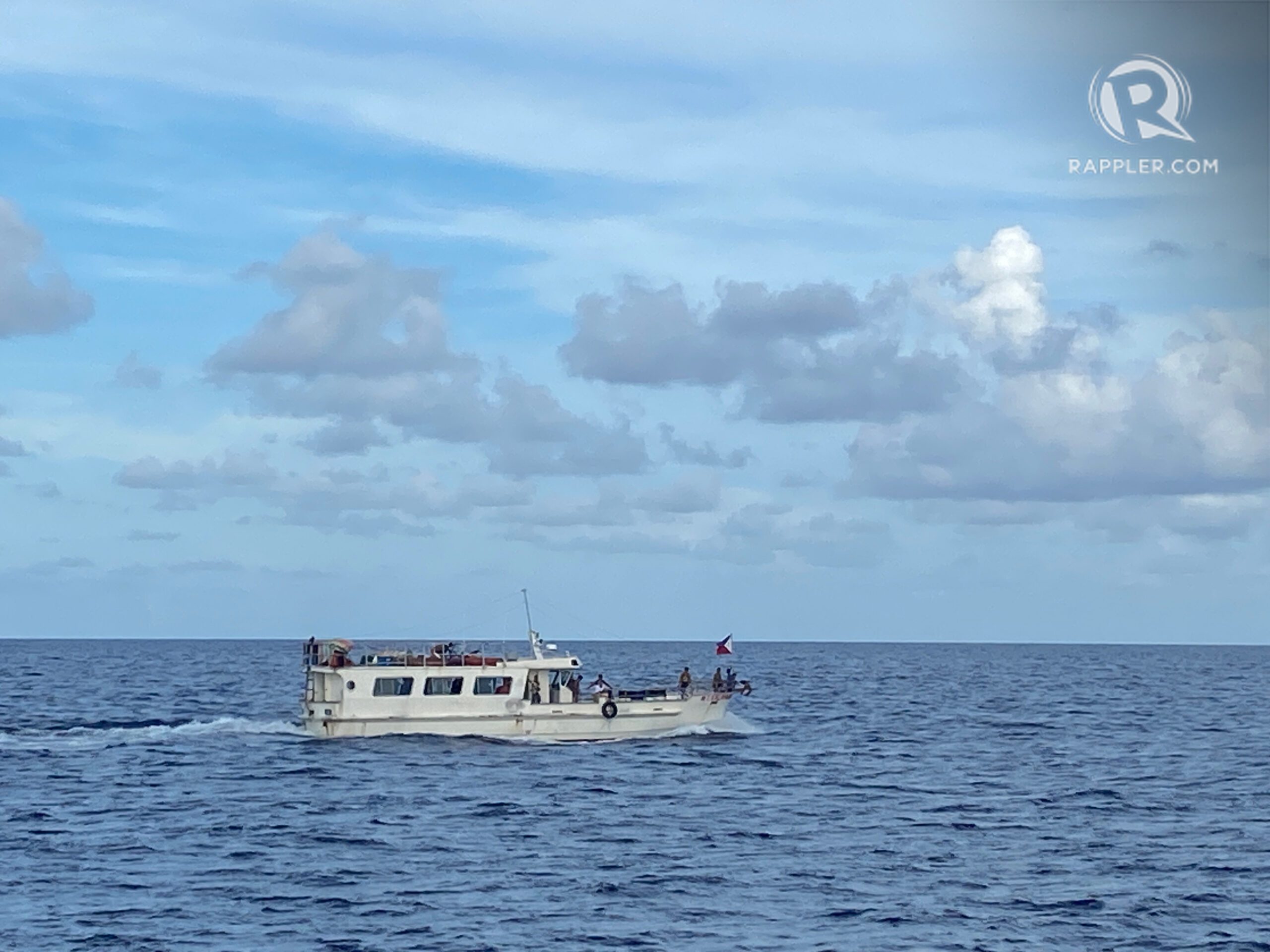SUMMARY
This is AI generated summarization, which may have errors. For context, always refer to the full article.

ABOARD THE BRP MELCHORA AQUINO – The morning sun had barely spread its rays across the BRP Cabra, BRP Sindangan, and BRP Melchora Aquino when, at around 6:30 am on Friday, November 10, several China Coast Guard (CCG) and Chinese Maritime Militia (CMM) ships first made a formation that would become all too familiar for those on board – one vessel each across, on the right and left, and even behind each Philippine Coast Guard (PCG) ship.
The PCG calls it the corraling of their vessels by China.
The Philippines Coast Guard (PCG)’s commandant, Admiral Ronnie Gavan, would later score the China Coast Guard (CCG) on Saturday, November 11, for “unprovoked acts of coercion and dangerous maneuvers” on a Philippine resupply mission to a Navy outpost in Ayungin Shoal.
The PCG, as has been the case for earlier resupply missions to Ayungin Shoal, is tasked to escort the smaller, military-contracted boats used to bring supplies to soldiers stationed at the BRP Sierra Madre, a World War 2 vessel that’s been run aground to serve as an outpost in the area.
At least five CCG ships, according to the PCG’s monitoring, actively participated in “dangerous maneuvers” – shadowing vessels at close-range, cutting across the path of PCG ships, and working in tandem with the Chinese Maritime Militia (CMM) to harass Philippine vessels.
Six CMM ships were active participants in the harassment of the three PCG ships and two resupply ships, although a total of 28 CMM vessels were monitored in the vicinity. Five vessels belonging to the People’s Liberation Army Navy or the Chinese Navy were also monitored in the area during the resupply mission, but these did not come close.
All in all, China deployed 38 of its vessels to the vicinity of Ayungin Shoal, compared to the five from the Philippines. The PCG said based on their monitoring from previous resupply missions, it’s the most number of ships China has deployed yet.
Gavan, who had only recently assumed the top PCG post, described the CCG’s actions as “systematic and consistent” and pointed out that they “do not align with the universally-accepted behavior of a coast guard.”
“Ironically, they are supposed to ensure safety of life at sea, but they are the one that deliberately violate the Convention on the International Regulations for Preventing Collisions at Sea, 1972 that the People’s Republic of China is also a signatory state [to]. The dangerous maneuverings of the CCG vessels are illegal and irresponsible actions that put into question and significant doubt their narrative of law enforcement and their real identity as a coast guard organization,” he said, speaking before the media in Manila.
PCG’s transparency push
The PCG chief added he was worried that China’s actions in Ayungin Shoal would be their “new norm.”
“It doesn’t really appear good to see a fellow coast guard violating rules they are supposed to uphold,” Gavan would add during the press conference.
Gavan said the PCG, “acted responsibly, consistent with rules-based international law, that aligns with the regional norm among the coast guard organizations in the region.”
“Our PCG skippers made sure that despite the reckless deployment of the CCG, we can still be able to prevent collision from happening,” he added.
China’s aggressive actions in the open sea, particularly during resupply missions to Ayungin Shoal, have been amplified in recent months, thanks in part of the PCG’s effort to publicize them.

Aside from making photos and videos of these incidents widely available to the public via social media, the PCG regularly invites select Filipino journalists working for media organizations, both based in Manila and abroad, to join these missions.
Rappler was among those who joined the November 10 resupply mission – first aboard the BRP Melchora Aquino, and then on the BRP Sindangan.
Hello, Sierra Madre
The November 10 mission was historic for the PCG, despite harassment by the Chinese vessels.
The BRP Cabra, BRP Sindangan, and the BRP Melchora Aquino managed to get the closest they had ever gotten to the mouth of Ayungin Shoal – less than two nautical miles from the BRP Sierra Madre. That meant that the World War II ship was visible to the naked eye for everyone on board the Philippine ships.
For the first time in months, the PCG also deployed the BRP Melchora Aquino, among its newest and most modern, to the November 10 mission.
Asked if the deployment of the 97-meter-long Melchora Aquino or its sister ship, the BRP Teresa Magbanua, would be a new default in Ayungin resupplies, Gavan said it would depend on the other tasks of the two ships.

“The 97-meter vessel has always been there. It is assigned there. Her deployment really depends on the magnitude of operation needs that we have in the area. In that instance, it was part of her routine movement. But we are not discounting the possibility that she will also be in other missions. But it cannot be a standard,” he said in a press conference on November 11 in Manila.
The journey to a successful mission was uneasy.
At early as midnight of November 10, CCG vessel 3303 was monitored already sailing close to the BRP Sindangan in the vicinity of Sabina Shoal.


By daybreak, 3303 was already sailing close to the 97-meter-long BRP Melchora Aquino – as close as 100 yards.
On board the Melchora Aquino, it was clear that the 3303 was tasked to never leave its side. There were two or three other CMM vessels – with bow numbers 00301, 00227, and 11004 – that also sailed close to the PCG vessel.
The 3303 and two of those CMM vessels would later corral the Melchora Aquino – 3303 across its bow, and the two CMM ships flanking it on the right and left.
The BRP Cabra and BRP Sindangan, much smaller and therefore more agile, were subject to even more dangerous harassment.
The BRP Cabra (MRRV 4409) zoomed ahead off the waters of Ayungin, leaving behind the BRP Sindangan (MRRV 4407) to escort the Unaizah Mae 1 and the ML Kalayaan, the two ships carrying supplies for the BRP Sierra Madre.
Unaizah Mae 2, one of two boats usually used for these missions, was still out of service after a collision during the last October 22 resupply mission.
Chinese ships tried to block the Unaizah Mae 1 early on in the morning. The Kalayaan had it worse – it was subject to water cannons by the CCG after the Sindangan, its escort, was separated by the CCG.
Before the water cannon incident, the Melchora Aquino also sped up, causing CCG ship 3303 and a blue CMM vessel to speed up as well. From a distance, we saw the Sindangan speeding across, too – it had finally managed to break away from the corral of Chinese ships.
Between 8:18 am to 8:25 am, the Unaizah Mae 1 and Kalayaan finally made it to Ayungin Shoal.

The use of water cannons and dangerous manuevers are part of China’s so-called “gray zone tactics” acts of aggression that stop short of actual military action. “Going dark” on the Automatic Information System (AIS) – the means by which vessels are monitored at sea – is also part of China’s playbook.
In the November 10 mission alone, several vessels – including CCG ships – were not on AIS but were present at sea.
‘Control’ of Ayungin
The Philippines would also deploy rigid-hull inflatable boats (RHIB) – one each from three PCG ships, and three from the BRP Sierra Madre itself – to escort and assist the Unaizah Mae 1 and Kalayaan as they finally made their way close to the Philippine outpost. China, in turn, deployed aluminum boats to chase after the supply boats.
The deployment of RHIBs served another purpose, according to PCG spokesperson for the West Philippine Sea Commodore Jay Tarriela – to assert Philippine control over Ayungin.
“We don’t want the Chinese government to still continuously argue that they have total control of Ayungin Shoal. With our capability to maintain our presence there with the RHIBs we deployed…it showed that we still have control of Ayungin Shoal,” said Tarriela in the same November 11 briefing.
Even after the resupply mission was over, the media contingent had left the Melchora Aquino, and it was on its way to nearby Panganiban Reef, CCG ship 3303 still shadowed and conducted “dangerous maneuvers,” said the PCG.
A CCG ship also shadowed the Cabra and Sindangan, vessels the media contingent used to sail home, until the two 44-meter ships reached Sabina Shoal.
While Tarriela refused to speculate on whether China was surprised by how the PCG and resupply ships avoided their blocking tactics, he was sure of one thing: China would be reassessing how things transpired that morning.
“I’m not really sure if that surprised them, that the [Philippine Coast Guard] reached that close to the entrance. Kung tayo nga (Even from our end), we noted that it’s the closest ever that we reached, I think the Chinese are also analyzing what really transpired – how come they were not able to block the three PCG vessels from getting close to Ayungin Shoal,” said Tarriela.
Why Ayungin matters
Ayungin Shoal, where the BRP Sierra Madre has been moored since 1999, is a flashpoint for tensions between Manila and Beijing in the South China Sea. Ayungin is one of several outposts in the area, but it’s only there where resupply missions are tense.
PCG personnel on board the Melchora Aquino noted that in other outposts, resupply missions were a breeze. If a CMM vessel seemed to be making trouble, the PCG would issue a warning and the maritime militia ship would almost always comply right away.
Ayungin Shoal is a low-tide feature that’s part of the Philippines’ exclusive economic zone. That means China has no business trying to stop Philippine ships from accessing the shoal or bringing supplies – including construction materials – to the BRP Sierra Madre.
“Only the Philippines can erect a structure or artificial island on Ayungin Shoal since under UNCLOS the coastal state has the exclusive right to erect structures or artificial islands within its EEZ,” said retired associate justice Antonio Carpio in a July 2023 speech, on the 7th anniversary of the 2016 arbitral award.
Carpio is among the foremost experts on the West Philippine Sea.

According to Carpio, it’s Ayungin Shoal’s location – roughly 20 nautical miles from Mischief Reef, where China has built its largest air and naval base in the Spratlys Islands, that makes it important to Beijing. “Naturally, China wants to control Ayungin Shoal,” he observed.
Ayungin is also close and is the nearest low-tide feature to Reed Bank, which is potentially rich in resources like oil and gas.
“Ayungin Shoal [is] a good monitoring post to oversee Reed Bank which is rich in gas deposits. If we want to safeguard Reed Bank, a good monitoring base is Ayungin Shoal,” said Carpio. Reed Bank is also within the Philippines EEZ, according to the 2016 ruling – which means the resources there are for the Philippines to exploit.
The BRP Sierra Madre, steadfast as it has been for over two decades, cannot last forever.
Despite the improvements it’s seen in recent times – there’s now internet connectivity aboard, for instance – there are visible holes in its hull. Structures that resemble shanties from afar cover its deck, manned by a handful of Filipino Marines at a time.
Without a long-term solution set in place – at least not publicly – resupply missions are crucial and mandatory.
The PCG certainly hopes tensions do not escalate even further. After a mission that featured 5 versus 11 – more than 30 if one counts the CMM and Chinese Navy ships in the area – what more awaits the PCG’s crew?
“Even if [China is] going to double, triple the vessels they will deploy, this one is certain: the PCG will not be deterred in carrying out the resupply mission,” Tarriela declared. – Rappler.com
Add a comment
How does this make you feel?











![[ANALYSIS] The West Philippine Sea dispute and the stock market’s performance](https://www.rappler.com/tachyon/2024/06/thought-leaders-west-ph-sea-dispute-and-market-performance.jpg?resize=257%2C257&crop=134px%2C0px%2C720px%2C720px)
![[ANALYSIS] High noon for Marcos](https://www.rappler.com/tachyon/2024/06/high-noon-for-marcos.jpg?resize=257%2C257&crop_strategy=attention)

![[Rappler Investigates] When China, Leila, Sara conspire](https://www.rappler.com/tachyon/2024/06/saraduterte-west-ph-sea-leila-de-lima-newsletter-june-27-2024.jpg?resize=257%2C257&crop=279px%2C0px%2C720px%2C720px)
There are no comments yet. Add your comment to start the conversation.